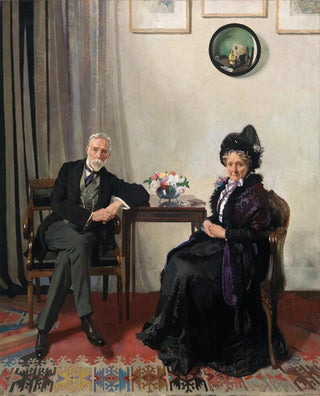Art print | Portrait of the artists' parents - William Orpen


View from behind

Frame (optional)
In the vast panorama of art history, some works stand out for their ability to transcend time and establish a dialogue between the past and the present. The "Portrait of the Artists' Parents" by William Orpen embodies this timeless essence. This piece, imbued with tenderness and respect, invites us to delve into the intimacy of an artist family, revealing the deep bonds that unite generations. Orpen, through this portrait, does not merely capture faces; he immortalizes emotions, stories, and legacies. Every brushstroke seems to whisper secrets, connecting us to a rich and vibrant artistic reality.
Style and uniqueness of the work
William Orpen's style is characterized by an unparalleled mastery of portraiture, where light and shadow dance with extraordinary delicacy. In this piece, the artist skillfully plays with nuances, creating an intimate atmosphere that envelops the subjects. The expressions of the parents, both serene and emotionally charged, testify to a rich life and a shared artistic journey. Orpen manages to capture not only the physical appearance but also the soul of his subjects, making each portrait a true window into their inner world. The composition, balanced and harmonious, guides the viewer's gaze while inviting deep contemplation. This painting, through its singularity, awakens in us a reflection on artistic legacy, on how influences are transmitted and transformed across generations.
The artist and his influence
William Orpen, an emblematic figure of the early 20th century, established himself as one of the most talented portraitists of his time. Trained at the Royal Academy of Arts in Dublin, he quickly developed a style that combines realism and sensitivity. His work is marked by a profound understanding of human psychology, allowing him to create portraits that go far beyond simple representation. Orpen captured the spirit of the times, integrating elements of modern life while respecting artistic traditions. His influence is felt not only in the field of portraiture but also in the way he redefined

Matte finish

View from behind

Frame (optional)
In the vast panorama of art history, some works stand out for their ability to transcend time and establish a dialogue between the past and the present. The "Portrait of the Artists' Parents" by William Orpen embodies this timeless essence. This piece, imbued with tenderness and respect, invites us to delve into the intimacy of an artist family, revealing the deep bonds that unite generations. Orpen, through this portrait, does not merely capture faces; he immortalizes emotions, stories, and legacies. Every brushstroke seems to whisper secrets, connecting us to a rich and vibrant artistic reality.
Style and uniqueness of the work
William Orpen's style is characterized by an unparalleled mastery of portraiture, where light and shadow dance with extraordinary delicacy. In this piece, the artist skillfully plays with nuances, creating an intimate atmosphere that envelops the subjects. The expressions of the parents, both serene and emotionally charged, testify to a rich life and a shared artistic journey. Orpen manages to capture not only the physical appearance but also the soul of his subjects, making each portrait a true window into their inner world. The composition, balanced and harmonious, guides the viewer's gaze while inviting deep contemplation. This painting, through its singularity, awakens in us a reflection on artistic legacy, on how influences are transmitted and transformed across generations.
The artist and his influence
William Orpen, an emblematic figure of the early 20th century, established himself as one of the most talented portraitists of his time. Trained at the Royal Academy of Arts in Dublin, he quickly developed a style that combines realism and sensitivity. His work is marked by a profound understanding of human psychology, allowing him to create portraits that go far beyond simple representation. Orpen captured the spirit of the times, integrating elements of modern life while respecting artistic traditions. His influence is felt not only in the field of portraiture but also in the way he redefined






